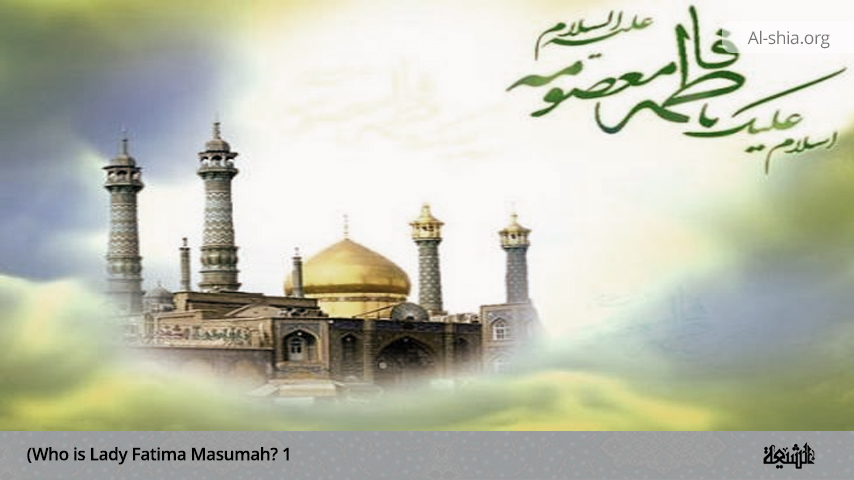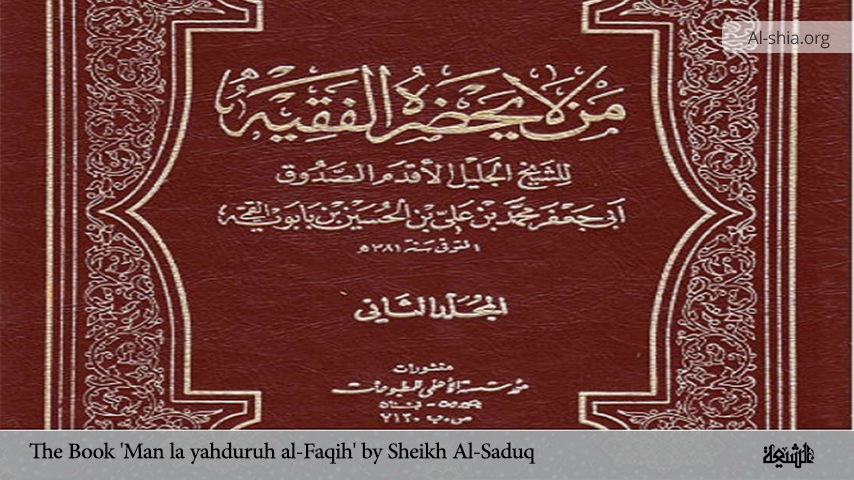Fatima Masumah is one holy and highly respected Ladies in Islam. She is the daughter of the Shia seventh Imam and the sister of the eighth Imam. Her shrine is in Qom and it is considered one of the most significant Shi’i shrines in Iran. Every year, thousands of Shi’i Muslims travel to Qom to honour her and ask for the blessings of Allah.
Predictions about this Noble Lady
It is interesting to know that Imams (a.s) have foretold the birth of this noble lady and her presence in Qom many years before her birth.
Qādī Nūrullāh Shūshtarī (d. 1109 A.H) reports from the sixth Imam, Imam Ja`far al-Sādiq (a.s):
“A lady from my children whose name will be Fatima, daughter of Mūsā, will die in Qom. On the Day of Judgement this lady will intercede for all my Shi`a to enter Heaven.”(1)
`Allāmah Majlisī narrates from Imam al-Sādiq (a.s):
“A lady from my children, by the name of Fatima, will be buried in Qom. Whoever visits her [shrine], will certainly be admitted to Heaven.”(2)
The writer of the above tradition says that Imam al-Sādiq (a.s) gave these glad tidings even before the birth of his son, the seventh Imam, Imam Mūsā al-Kazim (a.s), the father of Lady Fatima Masuma (a.s).
Since Imam al-Kazim (a.s) was born in 128 A.H and Lady Fatima Masuma (s.a) in 173 A.H; this speech was made at least 45 years before her birth.
Therefore, the good news of her birth was foretold more than 45 years before she was born!
Her birth
According to certain traditions, some of which are mentioned below, Lady Fatima Masumah (s.a) was born on the 1st of Dhul Qa`dah, 173 A.H in Medina.
1. The narrator Ayatollah Shaykh Ali Namāzī (d. 1405 A.H) writes: “Fatima Masumah was born at the beginning of the month of Dhul Qa’dah in the year 173 A.H” (3).
2. Mullā Muhsin Fayd narrates: “Lady Fatima [Masuma], daughter of Imam al-Kazim (a.s) was born in Medina at the beginning of the month Dhul Qa’dah in the year 173 A.H and she passed away in Qom on the 10th of the month Rabī` al-Thānī in the year 201 A.H (4).
Others who have also written that the birth of Lady Fatima Masuma (A) is at the beginning of the month of Dhul Qa’dah are mentioned below:
1. `Allāmah Bahrānī in his book `Awālim al-`Ulūm, vol. 21, p. 328.
2. Shaykh Mahdi Mansūrī in his book Hayāt Al-Sadāt, p. 10.
3. Dr. Muhammad Hādī Amīnī in his book Fātimah Bint al-Imam Mūsā al-Kazim, p. 21.
4. Ahmad Zādeh in his book Zendegānī Hadrat Mūsā Ibn Ja`far, vol. 2, p. 375.
Some of the authors above have recorded the year of the birth of Lady Fatima Masuma (A) as 183 A.H instead of 173 A.H, but this is incorrect on account of two major points, which are:
- If we study the details of Imam Mūsā al-Kazim’s (A) life, we see that on the 25th Rajab 183 A.H, he died in prison in Baghdad. We also know the minimum amount of time he spent in prison was four years; during this imprisonment, his family was in Medina. So it cannot be possible for Lady Fatima Masumah (A) to be born in the same year of 183 A.H.
- Also, it is well documented that Imam al-Kazim (a.s) had more than one daughter named Fatima, and that Lady Fatima Masumah (s.a) was the eldest Fatima (Fātimat al-Kubrā), therefore she could not have been born in the same year as the year of her father’s death.
From the foregoing, it can be seen that it is not possible that Lady Fatima Masumah (s.a) was born in the year 183 A.H, and the authors who have quoted this date have made a mistake, (either in counting or writing) and should have recorded 173 A.H.
Her death
There is no difference of opinion on the fact that Lady Fatima Masumah (s.a) died in Qom in the year 201 A.H.
The year of her death is further corroborated by the tiles in her shrine, dating back from centuries ago, which have the same date written on them. (5)
However, there are various possibilities about the month and day of her death:
1. 10th Rabī` al-Thānī (6)
2. 12th Rabī` al-Thānī (7)
3. 8th Sha`bān (8)
There is no evidence to say which of the three dates is correct, and so the scholars have decided that because the first and the second dates are so close together, the mourning for the death of this noble lady should be over three days period (10th, 11th and 12th of Rabī` al-Thānī). This three-day period is called: “the days of Masumah”.
Lady Fatima Masumah (a.s) was about 28 years old when she died. However, some scholars have said that at the time of her death her age was 18 (from the mistake of the year of her birth – 183 A.H instead of 173 A.H) and others have said her age was 23, but this last narration is not very reliable, due to its weak chain of transmission.
Her father
The father of Lady Fatima Masumah (s.a) was the seventh Imam – Imam Mūsā al-Kazim (a.s). It has been recorded in history that Imam al-Kazim (a.s) had numerous children.
Shaykh Mufīd (d. 413 A.H) writes that Imam al-Kazim (a.s) had 37 children, 19 sons and 18 daughters; and that two of these daughters were named Fatima – Fatima al-Kubrā and Fatima al-Sughrā. (9)
Sibt ibn Jawzī, the famous 8th-century scholar of the Ahl al-Sunnah, narrates that four daughters of Imam al-Kazim (A) were named Fatima: Fatima al-Kubrā, Fatima al-Wustā, Fatima al-Sughrā and Fatima al-Ukhrā. (10) Fatima al-Kubrā is the very same Lady Fatima Masumah (A) buried in Qom.
It is narrated that Fatima al-Wustā is buried in Isfahān and her Haram is called Sittī Fatima. Fatima al-Sughrā is well known as “Bībī Heybat”.
She is buried in Azerbaijan (11), where the beautiful dome and gardens at her shrine were destroyed during the era of Communist Russia. Fatima al-Ukhrā, who is also known as Fatima Tāhira, is buried in Rasht, Iran. (12)
The contemporary researcher, `Allāmah Shaykh Muhammad Taqī Tustarī writes:
Amongst all the children of Imam al-Kazim (A), other than Imam Ali al-Reza (a.s) there was no one equal in status to Lady Fatima Masumah (s.a). (13)
In 173 A.H, Hārūn al-Rashīd became the Caliph. Six years later, on the 20th Shawwāl 179 A.H, he ordered Imam al-Kađim (a.s) to be arrested in Medina.
At the time of his arrest, Imam (a.s) was in the state of prayers in the Prophet’s (s.a.w.a) mosque. After his arrest, he was brought to Iraq, where he was imprisoned in the dungeons of Baghdad. This is where Imam (a.s) spent the rest of his life.
Hārūn had the Imam (a.s) poisoned, and he died in the prison of Baghdad on the 24th or the 25th of Rajab in the year 183 A.H.
He is buried in the “Maqābir Quraysh” which is now known as Kazimayn because the 9th Imam – Imam Muhammad al-Taqī (A) is also buried there. (14)
From the dates above, we can conclude that Imam (A) was in prison for four years. However, some historians have quoted that his time in prison was seven years, and Ibn Jawzī mentioned that it was eleven years. (15)
To be continued!
NOTES:
______________________
1. Bihār al-Anwār, vol. 60, p. 228; Majālis al-Mu’minīn, vol. 1, p. 83.
2. Bihār al-Anwār, vol. 48, p. 317 & vol. 60, p. 216 & vol. 102, p. 266.
3. Shaykh `Alī Namāzī, Mustadrak Safīnat al-Bihār, vol. 8, p. 257.
4. Abbās Faid, Ganjīne-ye Athār-e Qum, vol. 1, p. 386.
5. Hasan ibn Muhammad Qummī, Tārikh-e Qadīm-e Qum, p. 213; Bihār al- Anwār, vol. 48, p. 290; Sayyid Muhsin Jabal `Āmilī, A`yān al-Shī`a, vol. 8, p. 391; Shaykh `Abbās Qummī, Muntahā al-Āmāl, vol. 2, p. 242; Sayyid Hasan al-Amīn, Dā’irat al-Ma`ārif, vol. 3, p. 231.
6. Mīr Abū Tālib Tabrīzī, Wasīlat al-Ma`sūmīn, p. 65; Sayyid Mahdī Mansūrī, Zindagāni-ye Hadrat-e Ma`sūma, p. 37, `Alī Akbar Mahdīpūr, Zindagāni-ye Karimah-ye Ahl al-Bayt, p. 105.
7. Mustadrak Safīnat al-Bihār, vol. 8, p. 257.
8. Shaykh Hurr ‘Āmilī, Risālat al-`Arabīyah al-‘Alawīyah, p. 11.
9. Shaykh Mufīd, Al-Irshād, Chapter on the life of Imam al-Kāđim (A).
10. Sibt ibn Jawzī, Tadhkirat al-Khawāss, p. 315.
11. Bihār al-Anwār, vol. 48, p. 317.
12. Ibid.
13. Shaykh Muhammad Taqī Tustarī, Tawārīkh al-Nabī wa al-Āl, p. 65.
14. Usūl al-Kāfī, vol. 1, p. 476; Al- Irshād, vol. 2, p. 215; `Alī bin Husain Mas`ūdī, Ithbāt al-Wasīyah, p. 161–169.
15. Tadhkirat al-Khawāss, p. 314.

















